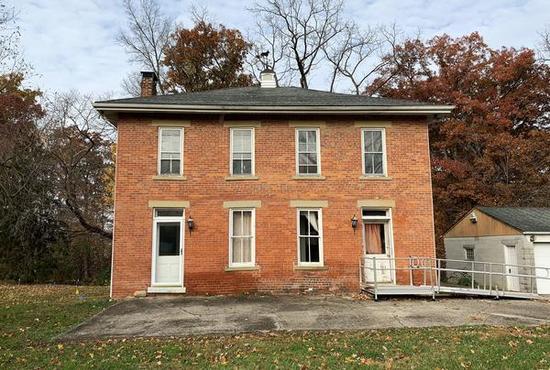Downloads
Full view (jpeg: 69.77 KB)
Learn more about copyright and access restrictions for use of materials from Worthington Memory.
Photograph of the Historic Ozem Gardner Homestead, November 8, 2018 is a picture, with genre photograph and historic buildings.
It was created on Thursday, November 8, 2018.
Flint Cemetery and Worthington Libraries are the Contributors. Gena Smith is the Photographer.
This is the front of the Historic Gardner Homestead as it appeared in November, 2018. The homestead was purchased by the Flint Cemetery in May, 2017, with plans to rehabilitate the building. The property adjoins the cemetery, separated only by a creek and ravine.
The home’s builder, Ozem Gardner, came to central Ohio from Ostego County, New York, in 1817. He worked as brickmaker until he could save enough money to purchase 65 acres of farmland on Flint Road in 1821. He lived in a log cabin until late 1830's. The brick farmhouse was built around 1850. An active member of the Anti-Slavery Society of Worthington, Gardner operated an Underground Railroad station on his property. It has been said that he assisted more than 200 enslaved people on their journey to seek freedom in Canada. Ozem Gardner lived in this home until his death in 1880.
A notable previous resident of the home was Henry Hancock and his family, who lived there for approximately 30 years. According to an interview with his granddaughter, Hancock was the first Black sheriff’s deputy in Franklin County. He also ran a business, Funeral Police Escort, for more than 40 years.
Small blue and yellow flags are visible in the ground to the left (west) of the house in this photo. At the time the photo was taken, researchers from The Ohio State University were using ground-penetrating radar in this area in an effort to find the answer to a decades-old legend. Behind the house is a brick shelter built into the ravine as it leads down to the creek; it was long believed that a tunnel ran from the shelter to the basement of the house, allowing enslaved people seeking their freedom to come into the house at night, when it was safe to do so. Researchers were unable to find evidence of the existence of this tunnel.
It covers the topics historic sites, Underground Railroad, slavery, African Americans, buildings and homes.
It features the person Ozem Gardner, 1797-1880.
You can find the original at Old Worthington Library.
This file was born digital in the format video/jpeg.
The Worthington Memory identification code is flc0002.
This metadata record was human prepared by Worthington Libraries on April 16, 2021. It was last updated July 16, 2021.

